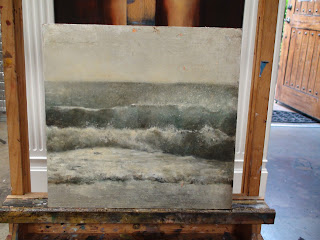A pentimento (according to Wikipedia), is "an alteration in a painting, evidenced by traces of previous work, showing that the artist has changed his or her mind as to the composition during the process of painting. The word is Italian for repentance, from the verb pentirsi, meaning to repent."
It can also be thought of as a sense of age or weather, the past, or history. When you create a pentimento on your surfaces it can add a unique enigma.
Another reason I like to play with this surface texture is that it can also add depth to what might end up being the usual treatment to an area of a painting.
This idea requires play and experimentation. It can be crazy or subdued, loud or quiet, elegant or gaudy. I have experimented with texture paste, marble dust, crackle varnish and wax, oil and acrylic paint, sponges, rags and other tools. Dry pigments into oil and wet pigments over and over. Guilding and encaustic, adding and subtracting by scrapping, sanding and abusing the surface.
Mostly, in my own art making, I paint very clean, smooth and velvety but by my own experimentation, I feel that I am a better teacher for my students in their pursuit of creating art.
Following are some details of pentimenti:
In this example I used several oil glazes on top of writing and then layered with gold foil.
This next example is very similar to the one above but is on a textured board, dark ground to begin then layered with foils, writing and more glazes.
This is a detail from one of my students paintings who typically paints several layers over the other and sometimes uses old paintings to paint on top of.
This next example was achieved by using a block of wood, dipping it into wet acrylic paint and allowing the irregular delivery of paint to become part of the history. By also limiting the final color overlay to a grayer tone, the colors seeping through give the piece more of an enigma.
This last example is a work in progress. It has texture paste and and crackle added. It needs to be sanded and glazed and then perhaps some encaustic? Or…dry pigments…the choices are endless and you just need to play and see what works. Just be sure that what you are doing is archival and will not start to come apart after a few years. Always work with water mediums first, then layer oils on top after they are very dry, never the opposite. Working on a stiff surface such as a gesso board or wood panel that has been sized or gessoed is a good start. If your surface is too flexible and you are using products that can crack then your final outcome could end up destroyed. Sanding in between layers is a good way to make sure that what ever you added before will stay.
If you would like to come and experiment with us, we have the perfect class on Thursday eves from 7 to 10pm at Kline Academy.
In the meantime, cheers to your art experimentation!
Cheryl Kline
































